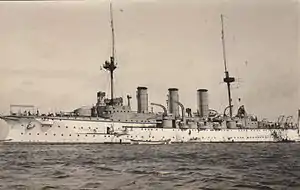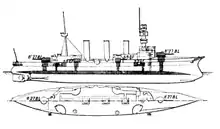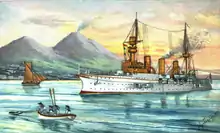SMS Freya
SMS Freya was a protected cruiser of the Victoria Louise class, built for the German Imperial Navy (Kaiserliche Marine) in the 1890s, along with her sister ships Victoria Louise, Hertha, Vineta, and Hansa. Freya was laid down at the Imperial Dockyard in Danzig in 1895, launched in April 1897, and commissioned into the Navy in October 1898. The ship was armed with a battery of two 21 cm guns and eight 15 cm guns and had a top speed of 19 knots (35 km/h; 22 mph).
 | |
| History | |
|---|---|
| Name: | Freya |
| Namesake: | Freya |
| Builder: | Kaiserliche Werft, Danzig |
| Laid down: | 1895 |
| Launched: | 27 April 1897 |
| Commissioned: | 20 October 1898 |
| Fate: | Scrapped in 1921 |
| General characteristics | |
| Class and type: | Victoria Louise-class protected cruiser |
| Displacement: | |
| Length: | 110.6 m (363 ft) |
| Beam: | 17.4 m (57 ft) |
| Draft: | 6.58 m (21.6 ft) |
| Installed power: |
|
| Propulsion: | |
| Speed: | 18.4 knots (34 km/h) |
| Range: | 3,412 nmi (6,319 km; 3,926 mi) at 12 kn (22 km/h; 14 mph) |
| Complement: |
|
| Armament: |
|
| Armor: |
|
Freya served in the German fleet for the initial years of her career, unlike her sister ships, all of which served abroad on foreign stations. As a result, she led a fairly uneventful career in the fleet. After a modernization in 1905–1907, Freya was used as a school ship for cadets. At the outbreak of World War I, Freya was mobilized into V Scouting Group, but served in front-line duty only briefly. She was used as a barracks ship after 1915, and ultimately sold for scrapping in 1921.
Design

In the early 1890s, elements in the German naval command structure grappled with what type of cruiser ought to be built to fulfill the various needs of the fleet. The Reichsmarineamt (RMA—Imperial Navy Office) preferred to build a combination of large cruisers of around 6,000 t (5,900 long tons) along the lines of SMS Kaiserin Augusta and significantly smaller vessels of about 1,500 t (1,500 long tons) to support them, while the Oberkommando der Marine (Naval High Command) argued that a uniform force of 3,000 t (3,000 long tons) cruisers was preferable. In the event, the RMA carried the day and three 6,000-ton cruisers were authorized in 1895. They resembled the larger Kaiser Friedrich III-class battleships, designed at the same time, albeit at reduced scale.[1]
Freya was 110.6 meters (363 ft) long overall and had a beam of 17.4 m (57 ft) and a draft of 6.58 m (21.6 ft) forward. As designed, she displaced 5,660 t (5,570 long tons), and at full load, her displacement rose to 6,491 t (6,388 long tons). Her propulsion system consisted of three vertical 4-cylinder triple-expansion steam engines, each driving a single screw propeller, with steam provided by twelve coal-fired Niclausse boilers. Her engines were rated for 10,000 metric horsepower (9,900 ihp), and provided a top speed of 19 knots (35 km/h; 22 mph). The ship had a range of approximately 3,412 nautical miles (6,319 km; 3,926 mi) at 12 kn (22 km/h; 14 mph). She had a crew of 31 officers and 446 enlisted men.[2]
The ship was armed with two 21 cm SK L/40 guns in single turrets, one forward and one aft. The guns were supplied with 58 rounds of ammunition each. They had a range of 16,300 m (53,500 ft). Vineta also carried eight 15 cm SK L/40 guns. Four were mounted in turrets amidships and the other four were placed in casemates. These guns had a range of 13,700 m (44,900 ft). She also carried ten 8.8 cm SK L/35 naval guns. The gun armament was rounded out by machine guns. She was also equipped with three 45 cm (18 in) torpedo tubes with eight torpedoes, two launchers were mounted on the broadside and the third was in the bow, all below the waterline.[3][4]
In 1916, all of the ships of the class were disarmed, with the exception of Freya, which was re-equipped with a single 15 cm gun, four 10.5 cm SK L/45 guns, and fourteen 8.8 cm guns of both the L/30 and L/35 versions, for use as a gunnery training ship.[4]
The ship was protected with Krupp armor; their deck was 4 cm (1.6 in) on the horizontal with sloped sides that were 10 cm (3.9 in) thick. Her main and secondary battery turrets had 10 cm thick sides and the secondary casemates had the same level of protection. The conning tower had 15 cm thick sides.[2]
Service history

Freya was ordered under the contract name "Ersatz Freya" and was laid down at the Imperial Dockyard in Danzig in 1895. She was launched on 27 April 1897, after which fitting-out work commenced. She was commissioned into the German navy on 20 October 1898. After her commissioning, Freya served with the German fleet.[2]
On 1 September 1902, Freya joined the Cruiser Division of the I Squadron of the German home fleet. The Division consisted of the armored cruiser Prinz Heinrich, the flagship, Victoria Louise, and the light cruisers Hela, Amazone, and Niobe. The Division participated in the summer fleet maneuvers of August–September 1902.[5] In 1905, Freya went into drydock at the Imperial Dockyard in Wilhelmshaven for modernization. During the refit she was re-boilered; she had been built originally with three stacks, and during the modernization they were trunked into two funnels. The refit was finished in 1907, after which Freya was used as a training ship for naval cadets.[2]
In 1907, Günther Lütjens served aboard the ship as a cadet; Lütjens went on to command the task force composed of Bismarck and Prinz Eugen in World War II.[6] In August 1908, Freya represented Germany at celebrations in Halifax, Canada, commemorating the 150th anniversary of the opening of the Canadian Parliament.[7] While entering the port at around midnight on 9 August, she inadvertently rammed a schooner in heavy fog. Nine sailors were killed in the accident.[8]
Freya had a short career during World War I. At the outbreak of hostilities, she was briefly mobilized into V Scouting Group, which was tasked with training cadets in the Baltic Sea. By the end of 1914, however, the ships were again removed from service.[9] She was then put into service as a coastal defense ship. After 1915, she was withdrawn from front-line duty again and returned to service as a training ship based in Flensburg. She served in this capacity through to the end of the war.[10] In 1915, Bernhard Rogge, who would go on to command the raider Atlantis during World War II, served aboard the ship as a cadet.[11] The old aviso Grille became Freya's tender starting in July 1915. She was stricken on 25 January 1920 and used briefly as a barracks ship for police in Hamburg. She was ultimately broken up for scrap in Harburg in 1921.[12]
Notes
- Dodson, p. 44.
- Gröner, pp. 47–48.
- Gardiner, p. 254.
- Gröner, p. 47.
- Brassey, p. 155.
- von Müllenheim-Rechberg, p. 63.
- Colby, p. 514.
- Hadley & Sarty, p. 49.
- Gardiner & Gray, p. 142.
- Gröner, p. 48.
- Slavick, p. 2.
- Gröner, pp. 48, 84.
References
- Brassey, T.A., ed. (1903). Brassey's Naval Annual. London: J. Griffin & Co.
- Colby, Frank Moore, ed. (1909). The New International Year Book. New York: Dodd, Mead & Company.
- Dodson, Aidan (2016). The Kaiser's Battlefleet: German Capital Ships 1871–1918. Barnsley: Seaforth Publishing. ISBN 978-1-84832-229-5.
- Gardiner, Robert, ed. (1979). Conway's All the World's Fighting Ships: 1860–1905. London: Conway Maritime Press. ISBN 978-0-85177-133-5.
- Gardiner, Robert & Gray, Randal, eds. (1985). Conway's All the World's Fighting Ships, 1906–1921. Annapolis: Naval Institute Press. ISBN 978-0-87021-907-8.
- Gröner, Erich (1990). German Warships: 1815–1945. Vol. I: Major Surface Vessels. Annapolis: Naval Institute Press. ISBN 978-0-87021-790-6.
- Hadley, Michael L. & Sarty, Roger Flynn (1991). Tin-pots and Pirate Ships: Canadian Naval Forces and German Sea Raiders, 1880–1918. Montreal: McGill-Queen's University Press. ISBN 0773507787.
- von Müllenheim-Rechberg, Burkhard (1980). Battleship Bismarck, A Survivor's Story. Annapolis: Naval Institute Press. ISBN 978-0-87021-096-9.
- Slavick, Joseph P. (2003). The Cruise of the German Raider Atlantis. Annapolis: Naval Institute Press. ISBN 1-55750-537-3.